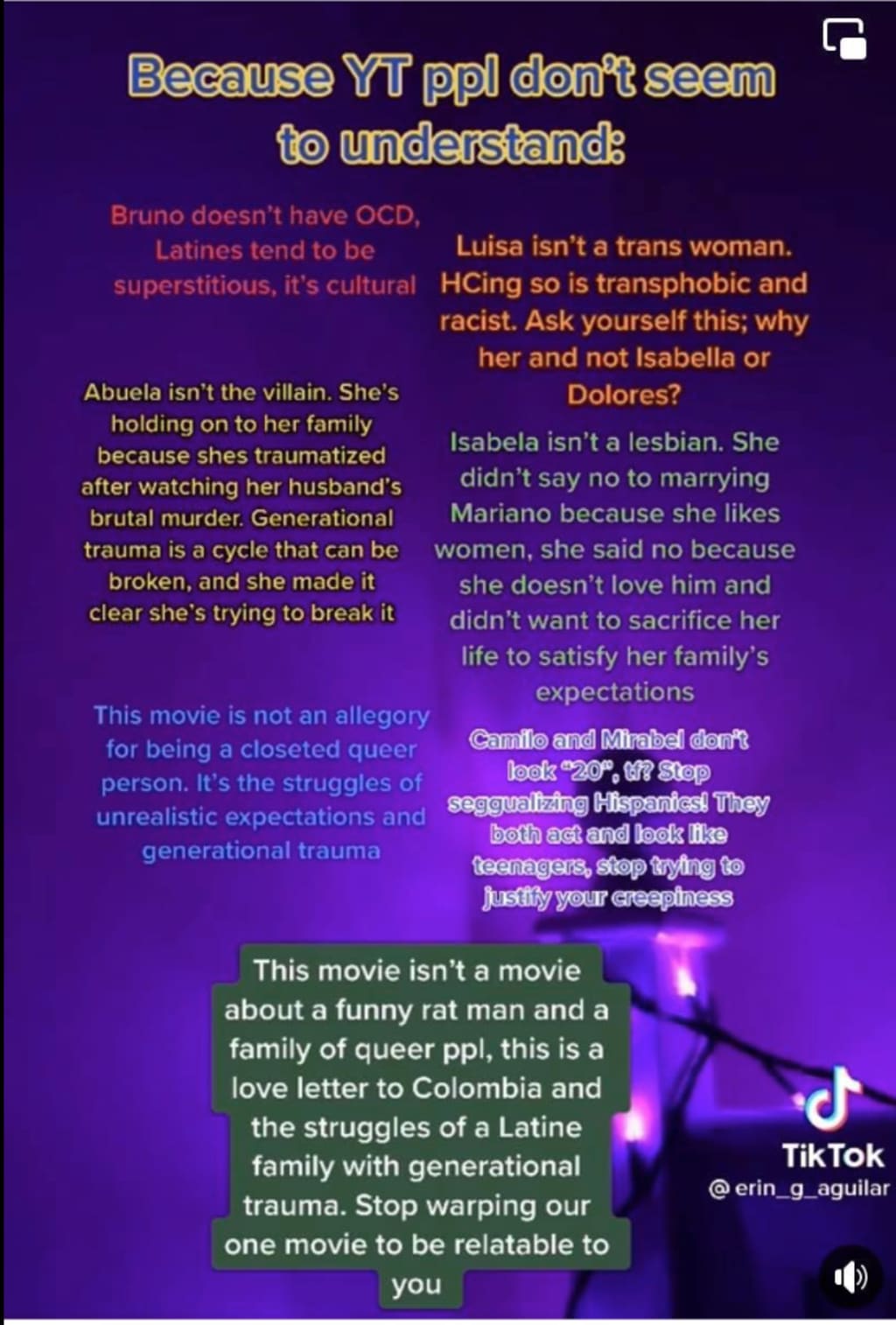Encanto Headcanons
When Inclusivity meets Erasure

I'm writing this as a published author and fanfic writer, but also as someone who is Queer and Neurodivergant. I'm also writing as a white non-Columbian, so if any POC, partiularly Latine POC, have corrections, I'm all ears.
OK, everyone, it's time to talk about headcanons, and when they cross the line from inclusivity to erasure.
I've been busy with other projects, so I haven't really had the chance to read much Encanto fanfiction. Nor have I had the time or inclination to trawl through pages and pages of First Person Self Insert fanfiction. (Seriously, just write an Original Character, having to read a Y/N character breaks the immersion...)
So, Some Background...
For those of you who have somehow failed to watch this awesome movie yet... stop reading and do so. It's awesome.
Now that you're back, let's dive in. Encanto is the story of Mirabel, a teenaged girl who lives in a magical sanctuary set in Columbia. She's also the only one in her family to not have received a magical gift. Her mother can heal with food, her aunt controls the weather... you know what, just watch the opening song.
The night that her younger cousin receives his gift, Mirabel receives a vision of Casita, their semi-sentient home, crumbling to ruins. No one else sees it, but the family's gifts slowly start to fade and falter, and Mirabel has to go on a quest to save her home and her family.
There are a lot of twists and a lack of traditional villains. Rather, "Encanto" is a story about family and healing, a tribute to Latine culture and Columbia in particular. It doesn't shy away from the fact that families can be complicated, and how hard it is to be the odd one out.
So, it's not really surprising that a lot of viewers, particularly Neurodivergant and non-Straight viewers, saw themselves in the characters, and started forming headcanons.
Encanto was groundbreaking in a lot of ways.
Leaving aside that it's Disney's first South American film since The Emperor's New Groove back in 2000, there were a lot of milestones.
The character designs were a break away from the usual uniform, doll-like statures, particularly buff Louisa, solid Tio Felix, and Mirabel, who while not out of the norm for an everyday teenager, probably verges on plus-sized at your average clothing store. The village is a solid mix of African-descent, Latine and Native. So it the Family Madrigal itself.
It drew explicit parallels to mental health, toxic positivity, and inter-generational trauma. It showed the plight of refugees driven from their home and forced to find a new one. It showed the pressure of trying to fit into a mold and the fear of disappointing your loved ones.
The soundtrack is almost reminiscent of a Jukebox Musical, with each song having a different kind of rhythm and beat. It's the first movie-length animated soundtrack by a female composer, Germaine Franco, even if Lin-Manuel Miranda set a new Personal Best for Songwriting.
No wonder Millennials hit the roof and kept going at Surface Pressure and What Else Can I do.
Surface Pressure: The new Mental Health Anthem
Move over, "This Is Me", this is the new self-acceptance soundtrack.
Encanto was described as "A Love Letter to Colombia", and the scriptwriters and animators worked closely with people from the region to get the culture, scenery and characters right.
Put a pin in that, it will be important later.
There's nothing wrong with headcanons, particularly when Hollywood in general and Disney in particular are reluctant to explicitly confirm characters as non-neurotypical or non-straight in anything more than blink-and-you'll-miss-it clips that can be edited out for more conservative international markets.
It's natural to imagine your favourite characters as having aspects that reflect your own feeling and experiences, especially with representation so thin on the ground.
But....
It's equally important not to get carried away, and to remember that your interpretations are not universal. It's also vital that you be respectful, both of the source material and of other fans, especially when it comes to other cultures and minorities.
You have to be aware of Stereotypes, because those aren't cute or inclusive, they're harmful.

Not every male character who is soft-spoken and gentle is Gay. A female character can be physically strong without being Trans. Female characters can be single without being Lesbian. A character can have quirks or habits without being OCD. An older character, in a position of leadership and from a generation that Doesn't Talk About Their Feelings, can unintentionally do harm without being Evil or Maliciously Abusive.
Characters are too complex to be defined by or reduced down to a single trait. If they aren't, then you're doing something wrong.
To be fair, this has been a problem in Fandom for a long time.
Fans want to relate to the characters, and they often do so by seeking out similarities to themselves. If those similarities don't exist, we project traits onto them.
Normally this is fine, and I'd argue that some headcanons actually improve the characters. I will never argue against blind casting, like in Bridgerton, and Mixed!Harry Potter or POC!Percy Jackson make a lot of sense to me.
However, it's important to be respectful of the source material, too.
If a character is a child in canon, you shouldn't sexualize them or ship them with an adult in a position of power over them. Incest is creepy and gross, no matter how attractive the actors are or how much chemistry they have on-screen. That goes double for shipping the actors themselves.
(I'm not going to name and shame here, but Fandoms, you know who you are)
It's also important to remember that Encanto is based on a real, living culture, not a mythical society or "inspired by" a long-fallen civilization. There are real people who saw themselves and their culture depicted positively for the first time, rather than a lawless jungle or sepia-toned Crime Base.
Countless non-White celebrities have spoken about how much it meant to them to play a character that was more than a Stereotype.
Whoopi Goldberg remembered seeing Nichelle Nichols as Uhura on Star Trek as a defining moment of her childhood, a black woman as something other than a domestic servant. Riz Ahmed spoke of his role in Star Wars: Rogue One as the first role where he wasn't typecast as a Terrorist or Villainous Minion. John Boyega and Oscar Isaac were on tour for months about being Star Wars's first non-white, non-Alien lead characters.
So, when Encanto shows Columbia and it's people as something other than a drug-ridden crime empire, it's important to pay attention to the differences between Encanto and the 'default' USA cultures. It's important to listen to Latine voices who say that throwing salt and knocking on wood are not signs of a mental disorder, but common superstitions. It's important to acknowledge Columbian people who point out that yes, Abuela's attitude and mentality was common for an older generation who spent most of their lives in a Conflict Zone, under tyranical governments who would send out special forces to wipe out entire villages and blame it on rebel fighters. It's important to acknowledge how much of a big deal it was that Abuela Alma admitted to her trauma and how it hurt her family, and worked to do better.
It's important to hear the Latine people who say how amazing it was to see Luisa be both super-strong and notably feminine, or how validated they felt when Isabela didn't want to marry Martino, not because she didn't like men or was in love with someone else, but because she simply didn't want to get married.
It's extra-important to listen to Trans BIPOC who tell you that singling out Luisa as Trans comes off as very Transphobic, or Neurodivergant BIPOC who ask you not to equate their cultural superstitions with mental illness.
Don't whine about Gatekeeping; Listen!
The important thing to remember here is nuance and stereotypes.
Trans head canons are fine, but if you're ONLY headcanoning the large, muscular, alto girl as Trans, you might want to check your bias. Why not "Miss Perfect" Isabela, who is intent on her looks because her appearance finally matches what she always felt she was inside? Why not Dolores? Why not Camilo, who can literally shapeshift, as Agender or Genderfluid?
Not every story needs a clear-cut Villain. Sometimes the Hero's Journey is a personal one, or a conflict within their family or community, rather than a deliberately malicious person. Good on Encanto for finally touching on this.
Bruno spent ten years living in the walls. He has plenty of issues to talk about and explore in fiction, but distilling superstitions and coping mechanisms down into "He's OCD!" is both hurtful and offensive.
It's ok to have head canons and write fiction, just don't erase already-marginalized communities in the process.
I'll do a more general post on Head-Canons later. Meanwhile, if you liked this story, leave a heart or a tip, and follow me on Vocal and Medium!
About the Creator
Natasja Rose
I've been writing since I learned how, but those have been lost and will never see daylight (I hope).
I'm an Indie Author, with 30+ books published.
I live in Sydney, Australia






Comments
There are no comments for this story
Be the first to respond and start the conversation.